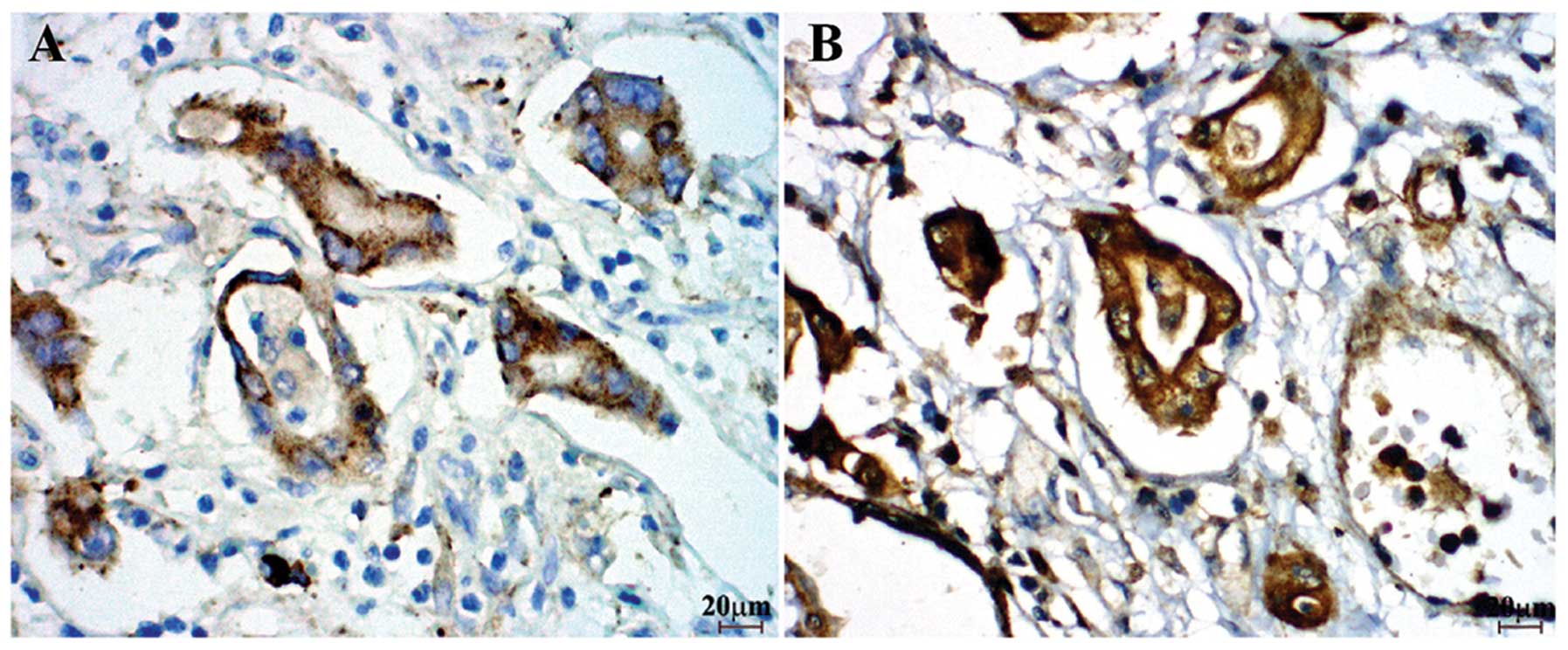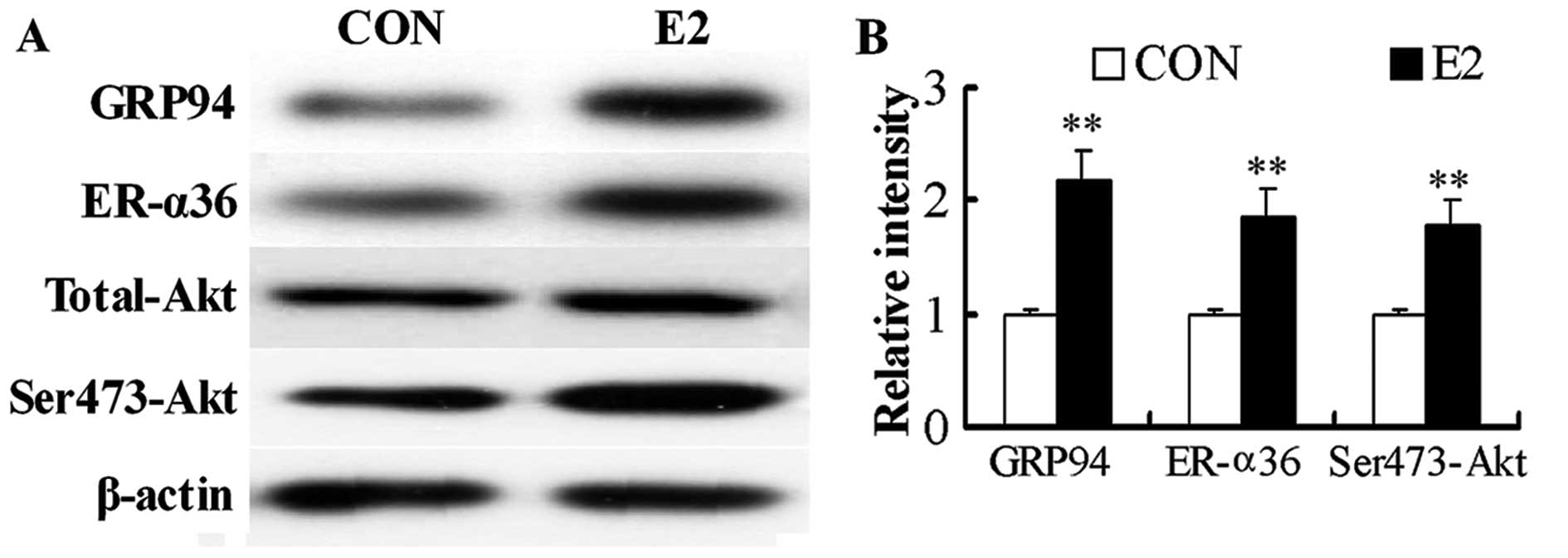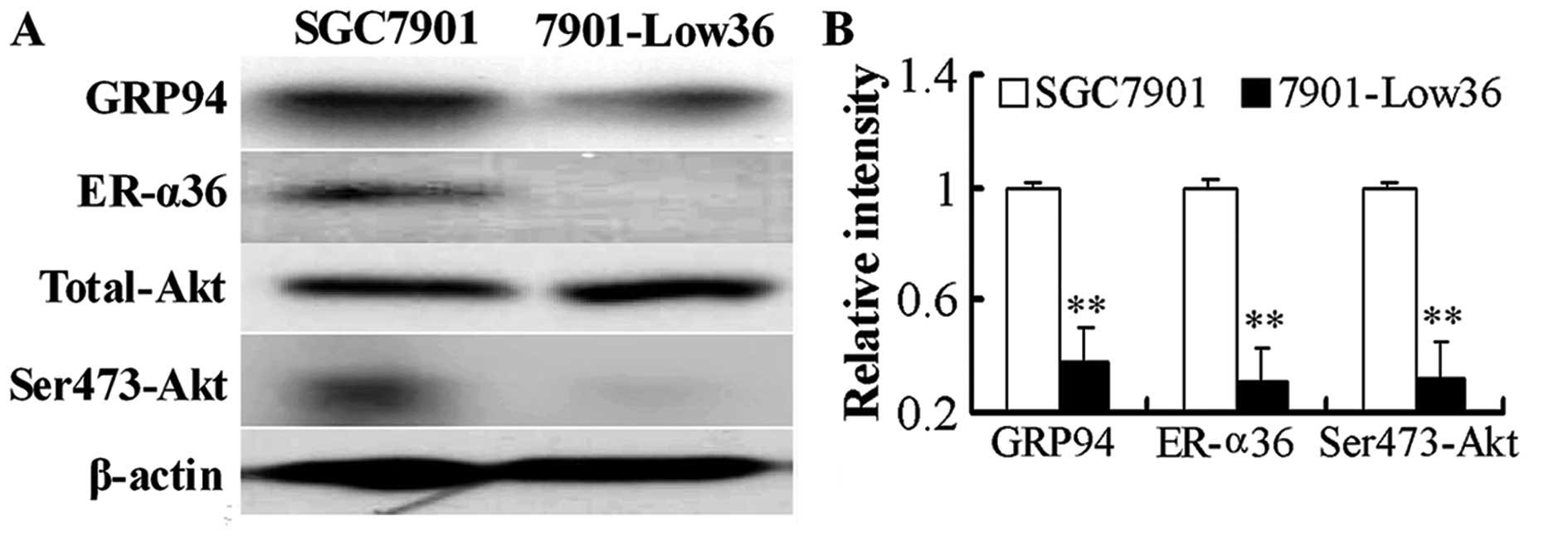Introduction
Glucose-regulated protein 94 (GRP94) is a molecular
chaperone in the endoplasmic reticulum that binds to misfolded
proteins and unassembled complexes, with an important role in the
maintenance of cellular homeostasis and the suppression of cell
death in stress conditions. GRP94 is highly expressed in cancer
tissues, and previous studies have shown that GRP94 is involved in
tumor proliferation, metastasis, drug resistance and immunotherapy
(1,2). In gastric carcinoma, GRP94
overexpression has been associated with increased tumor size,
increased depth of invasion, lymphatic and venous invasion, and
advanced stage (3). GRP94 cleavage,
induced by honokiol through calpains, has been shown to induce
apoptosis in human gastric cancer cells and reduce gastric tumor
growth (4). However, the
involvement of GRP94 in carcinogenesis has not been well
established.
Gastric cancer is the fourth most common type of
cancer and the second leading cause of cancer-related mortality
worldwide (5,6). Epidemiological studies have
demonstrated a global gastric cancer predominance in males.
Tamoxifen, an antiestrogen agent, has been shown to accelerate
tumor progression and increase the overall risk of gastric
adenocarcinoma (7,8). These findings suggest an association
between estrogen signaling and the pathogenesis of gastric cancer.
Previous studies have found that estrogen receptor-α36 (ER-α36), a
novel variant of ER-α, is highly expressed in human gastric cancer,
and that ER-α36 expression levels were positively correlated with
lymph node metastasis and GRP94 expression levels (3,9,10).
However, the molecular mechanism by which ER-α36 functions through
GRP94 in the pathogenesis of gastric cancer remains unclear.
In the present study, GRP94 and ER-α36 expression
levels in gastric cancer samples were examined. To clarify the
mechanism of GRP94 involvement in gastric carcinogenesis through
ER-α36 signaling, SGC7901 human gastric adenocarcinoma cells were
treated with 17β-estradiol (E2) and the expression levels of GRP94
and ER-α36, and the phosphorylation levels of Akt at the Ser473
site (Ser473-Akt) were measured. GRP94 and Ser473-Akt levels were
also determined in established gastric cancer cells with knockdown
of ER-α36 expression.
Materials and methods
Antibodies and chemicals
17β-E2 was purchased from Sigma-Aldrich (St. Louis,
MO, USA). Polyclonal rabbit anti-mouse, anti-rat, anti-cow,
anti-dog and anti-human GRP94 antibody was obtained from Abcam
(Cambridge, UK). The monoclonal rabbit anti-human phospho-Akt at
Ser473 (Ser473-Akt) antibody was purchased from Cell Signaling
Technology, Inc. (Danvers, MA, USA). The rabbit anti-ER-α36
antibody was generated and characterized as previously described
(11). The mouse anti-β-actin
antibody was purchased from Santa Cruz Biotechnology, Inc. (Santa
Cruz, CA, USA). Bicinchoninic acid protein detection kits, goat
anti-mouse peroxidase-conjugated secondary antibody,
chemiluminescence substrate kits and polyvinylidene difluoride
(PVDF) membranes were obtained from Pierce Biotechnology, Inc.
(Rockford, IL, USA). A third-generation SuperPicture
immunohistochemistry (IHC) Detection kit was obtained from
Invitrogen Life Technologies (Carlsbad, CA, USA). The
radioimmunoprecipitation assay (RIPA) buffer and enhanced
chemiluminescence reagents were obtained from the Beyotime
Institute of Biotechnology (Shanghai, China).
Cell culture
The SGC7901 human gastric adenocarcinoma cell line
was obtained from the Cell Center of Basic Medicine, Chinese
Academy of Medical Sciences (Beijing, China). SGC7901-low36, a
gastric cancer cell line with knockdown of ER-α36 expression was
established using the lentiviral small hairpin RNA method (11). The SGC7901 and SGC7901-low36 cells
were cultured in RPMI-1640 medium (Gibco-BRL, Carlsbad, CA, USA)
containing 10% fetal calf serum (FCS; HyClone Laboratories, Inc.,
Logan, UT, USA) at 37°C in a 5% CO2 atmosphere.
17β-E2 treatment
The cells were plated at a density of
1×106 cells per 100-mm dish for 24 h, then washed with
phosphate-buffered saline (PBS) and placed in phenol-red-free
medium (Invitrogen Life Technologies, Carlsbad, CA, USA) with 5%
charcoal-stripped FCS (HyClone Laboratories, Inc.) for 6 h, and
then in 2% charcoal-stripped FCS (HyClone Laboratories, Inc.) for
24 h prior to the experiments. The cells were treated with 17β-E2
at a concentration of 10−12 M and vehicle (dehydrated
alcohol) for 24 h.
Gastric tumor samples
Paraffin-embedded tumor tissues from gastric cancer
patients were obtained from the Jiangda Pathology Institute (Wuhan,
China) between 2008 and 2009 following the approval of the
Institutional Review Board. For immunohistochemical analysis, the
tumor tissues were fixed in 10% neutral formalin, embedded in
paraffin, and stained with hematoxylin and eosin. None of the
patients had received any anticancer treatment prior to surgery.
Written informed consent was obtained from all patients. This study
was approved by the ethics committee of the School of Medicine,
Jianghan University (Wuhan, China).
Western blot analysis
Western blot analysis was performed according to
methods previously established (12). Briefly, the cells were lysed and
homogenized with RIPA buffer. The protein concentration was then
estimated with the bicinchoninic acid kit according to the
manufacturer’s instructions. The proteins were separated by 10%
SDS-polyacrylamide gel electrophoresis and transferred to the PVDF
membranes. The membranes were blocked with 5% non-fat milk
dissolved in TBS-Tween-20 (containing 50 mm Tris HCl, pH 7.6, 150
mm NaCl and 0.2% Tween-20) for 1 h and probed with the primary
antibodies (1;1,000) at 4°C overnight. The blots were then
incubated with monoclonal goat anti-mouse or polyclonal goat
anti-rabbit IgG conjugated to horseradish peroxidase (1:5,000) for
1 h at 37°C, and visualized with enhanced chemiluminescence. The
blots were quantitatively analyzed by TotalLab analysis software
(Nonlinear Dynamics Technical, NC, USA).
Immunohistochemical assay
Immunohistochemical staining was conducted on 4-μm
tumor sections via a ‘two-step’ assay (9). Briefly, the tissue slides were
deparaffinized with xylene and rehydrated using a gradual alcohol
series. Endogenous peroxidase activity was inhibited by incubating
the slides in a 3% hydrogen peroxide/methanol buffer for 10 min.
Antigen retrieval was performed by immersing the slides in EDTA
buffer (pH 8.0) followed by boiling in a water bath for 25 min. The
slides were subsequently rinsed in PBS and then incubated overnight
at 4°C in a humidified chamber with either polyclonal anti-GRP94
antibodies at a dilution of 1:100 or polyclonal anti-ER-α36
antibodies at a dilution of 1:400. The slides were then incubated
with the secondary antibody (horseradish peroxidase-conjugated
polyclonal goat anti-rabbit Ig; 1:100; Invitrogen Life
Technologies) for 30 min. Diaminobenzidine served as a chromagen
and the slides were counterstained with hematoxylin. Images were
observed and captured using an Olympus BX53 microscope and an
Olympus DP72 digital camera, respectively (Olympus Corporation,
Tokyo, Japan).
Statistical analysis
SPSS 12.0 software (SPSS, Inc., Chicago, IL, USA)
was used to conduct the analysis. All analyses were performed using
Student’s t-test. P<0.05 was considered to indicate a
statistically significant difference.
Results
GRP94 and ER-α36 are highly expressed in
gastric tumors
The GRP94 and ER-α36 expression levels were examined
in the specimens from gastric carcinoma patients using IHC assay.
GRP94 and ER-α36 were highly expressed in the cytoplasms of gastric
carcinoma cells (Fig. 1).
E2 increases the protein expression
levels of GRP94, ER-α36 and Ser473-Akt
To investigate the involvement of GRP94 in gastric
cancer estrogen signaling, the SGC7901 human gastric adenocarcinoma
cells were treated with 10−12 M E2 for 24 h (14). Western blotting and quantitative
analysis revealed a significant increase in Ser473-Akt, GRP94 and
ER-α36 expression levels (P<0.01 for each; Fig. 2).
ER-α36-mediated signaling regulates GRP94
expression through the Akt signaling pathway
To further analyze the function of the Akt signaling
pathway in ER-α36-GRP94 signaling, GRP94, ER-α36 and Ser473-Akt
expression levels were examined in SGC7901-Low36 cells with
knockdown of ER-α36 expression. Significant reductions in GRP94 and
Ser473-Akt expression levels were observed in these cells compared
with SGC7901 control cells transfected with an empty expression
vector (P<0.01 for each; Fig.
3). These results suggest that the Akt signaling pathway is
involved in ER-α36-mediated estrogen signaling through GRP94 in
gastric carcinogenesis.
Discussion
GRP94 is a chaperone in the endoplasmic reticulum
that, under basal expression, controls normal physiological
functions; however, GRP94 is also induced in pathological
conditions, for example, hypoxia and nutrient deprivation (15). Under malignant conditions, GRP94
expression is upregulated and has been shown to be involved in the
pathogenesis, growth, invasion and metastasis of gastric carcinoma
(16). In our previous study, GRP94
was found to be highly expressed in human gastric adenocarcinoma
tissues (3). The levels of GRP94
expression were significantly correlated with gender, tumor stage,
lymph node metastasis and the expression levels of ER-α36, which is
highly expressed in human gastric cancer and is involved in the
malignant growth of gastric carcinoma cells (9,10). As
estrogen is known to induce the expression of GRPs (3), this suggested that GRP94 may be
involved in gastric carcinogenesis through ER-α36-mediated estrogen
signaling.
Akt (also known as protein kinase B) is a
serine/threonine protein kinase known to regulate the balance
between cell survival and apoptosis (17). Activated Akt expression induces cell
survival, whereas inhibition of Akt activity stimulates apoptosis
(18,19). Studies have shown that the
overexpression and/or activation of Akt occurs in gastric cancer
(20,21), and that the phosphoinositide
3-kinase/Akt signaling pathway is important in the chemoresistance
of gastric cancer cells against the cell death induced by etoposide
and doxorubicin (22). These
results suggest that the Akt signaling pathway is involved in tumor
proliferation and drug resistance. In addition, E2 promptly
activates the PI3K/Akt signaling pathway in Ishikawa cells in an
ER-dependent and ER-independent manner in HEC-1A cells (23). E2 treatment has been demonstrated to
increase the phosphorylation of Akt on Ser473 (Akt1), but does not
activate Akt2 (on Ser474); furthermore, ER-α is required for Akt1
activation (24). Akt1 may increase
ER-α protein levels, while simultaneously reducing transcriptional
activity (25). In the present
study, to clarify the mechanisms involving GRP94 in the
pathogenesis of gastric cancer induced by the ER-α36 signaling
pathway, SGC7901 cells were treated with E2; increased GRP94 and
ER-α36 expression levels, as well as increased phosphorylation
levels of Akt at Ser473, were observed. By contrast, in established
gastric cancer cells with knockdown of ER-α36 expression, GRP94 and
Ser473-Akt expression levels were significantly reduced. These
results suggest that Akt may be a key downstream effector of
ER-α36-GRP94-mediated signaling in gastric carcinogenesis.
In conclusion, in the present study, high expression
levels of GRP94 and ER-α36 were identified in gastric cancer
tissues. Furthermore, E2 treatment increased the expression levels
of GRP94, ER-α36 and Ser473-Akt. In established gastric cancer
cells with knockdown of ER-α36 expression, GRP94 and Ser473-Akt
expression levels were significantly reduced. Thus, the Akt
signaling pathway is a potentially important signaling pathway
involved in ER-α36/GRP94-mediated signaling in gastric
carcinogenesis.
Acknowledgements
This study was supported by the National Natural
Science Foundation of China (grant nos. 30870981 and 81272754), the
Natural Science Foundation of Hubei Province (grant no. 2013CFB215)
and the Foundation of Hubei Provincial Department of Education
(grant no. B2014079).
References
|
1
|
Li J and Lee AS: Stress induction of
GRP78/BiP and its role in cancer. Curr Mol Med. 6:45–54. 2006.
|
|
2
|
Srivastava PK: Therapeutic cancer
vaccines. Curr Opin Immunol. 18:201–205. 2006.
|
|
3
|
Fu Z, Deng H, Wang X, et al: Involvement
of ER-alpha36 in the malignant growth of gastric carcinoma cells is
associated with GRP94 overexpression. Histopathology. 63:325–333.
2013.
|
|
4
|
Sheu ML, Liu SH and Lan KH: Honokiol
induces calpain-mediated glucose-regulated protein-94 cleavage and
apoptosis in human gastric cancer cells and reduces tumor growth.
PLoS One. 2:e10962007.
|
|
5
|
Lambert R, Guilloux A, Oshima A, et al:
Incidence and mortality from stomach cancer in Japan, Slovenia and
the USA. Int J Cancer. 97:811–818. 2002.
|
|
6
|
Brenner H, Rothenbacher D and Arndt V:
Epidemiology of stomach cancer. Methods Mol Biol. 472:467–477.
2009.
|
|
7
|
Chandanos E, Lindblad M, Rubio CA, et al:
Tamoxifen exposure in relation to gastric adenocarcinoma
development. Eur J Cancer. 44:1007–1014. 2008.
|
|
8
|
Rutqvist LE, Johansson H, Signomklao T, et
al: Adjuvant tamoxifen therapy for early stage breast cancer and
second primary malignancies. Stockholm Breast Cancer Study Group. J
Natl Cancer Inst. 87:645–651. 1995.
|
|
9
|
Deng H, Huang X, Fan J, et al: A variant
of estrogen receptor-alpha, ER-alpha36 is expressed in human
gastric cancer and is highly correlated with lymph node metastasis.
Oncol Rep. 24:171–176. 2010.
|
|
10
|
Wang X, Deng H, Zou F, et al:
ER-alpha36-mediated gastric cancer cell proliferation via the c-Src
pathway. Oncol Lett. 6:329–335. 2013.
|
|
11
|
Wang Z, Zhang X, Shen P, et al: A variant
of estrogen receptor-α, hER-α36: transduction of estrogen- and
antiestrogen-dependent membrane-initiated mitogenic signaling. Proc
Natl Acad Sci USA. 103:9063–9068. 2006.
|
|
12
|
Fu ZQ, Yang Y, Song J, et al: LiCl
attenuates thapsigargin-induced tau hyperphosphorylation by
inhibiting GSK-3beta in vivo and in vitro. J Alzheimers Dis.
21:1107–1117. 2010.
|
|
13
|
Deng H, Zhen H, Fu Z, et al: The
antagonistic effect between STAT1 and Survivin and its clinical
significance in gastric cancer. Oncol Lett. 3:193–199. 2012.
|
|
14
|
Kang L, Zhang X, Xie Y, et al: Involvement
of estrogen receptor variant ER-alpha36, not GPR30, in nongenomic
estrogen signaling. Mol Endocrinol. 24:709–721. 2010.
|
|
15
|
Suntharalingam A, Abisambra JF, O’Leary JC
III, et al: Glucose-regulated protein 94 triage of mutant myocilin
through endoplasmic reticulum-associated degradation subverts a
more efficient autophagic clearance mechanism. J Biol Chem.
287:40661–40669. 2012.
|
|
16
|
Zheng HC, Takahashi H, Li XH, et al:
Overexpression of GRP78 and GRP94 are markers for aggressive
behavior and poor prognosis in gastric carcinomas. Hum Pathol.
39:1042–1049. 2008.
|
|
17
|
Jones PF, Jakubowicz T, Pitossi FJ, Maurer
F and Hemmings BA: Molecular cloning and identification of a
serine/threonine protein kinase of the second-messenger subfamily.
Proc Natl Acad Sci USA. 88:4171–4175. 1991.
|
|
18
|
Garcia GE, Nicole A, Bhaskaran S, et al:
Akt-and CREB-mediated prostate cancer cell proliferation inhibition
by Nexrutine, a Phellodendron amurense extract. Neoplasia.
8:523–533. 2006.
|
|
19
|
Gottlob K, Majewski N, Kennedy S, et al:
Inhibition of early apoptotic events by Akt/PKB is dependent on the
first committed step of glycolysis and mitochondrial hexokinase.
Genes Dev. 15:1406–1418. 2001.
|
|
20
|
Ang KL, Shi DL, Keong WW and Epstein RJ:
Upregulated Akt signaling adjacent to gastric cancers: implications
for screening and chemoprevention. Cancer Lett. 225:53–59.
2005.
|
|
21
|
Oki E, Baba H, Tokunaga E, et al: Akt
phosphorylation associates with LOH of PTEN and leads to
chemoresistance for gastric cancer. Int J Cancer. 117:376–380.
2005.
|
|
22
|
Yu HG, Ai YW, Yu LL, et al:
Phosphoinositide 3-kinase/Akt pathway plays an important role in
chemoresistance of gastric cancer cells against etoposide and
doxorubicin induced cell death. Int J Cancer. 122:433–443.
2008.
|
|
23
|
Guo RX, Wei LH, Tu Z, et al: 17
beta-estradiol activates PI3K/Akt signaling pathway by estrogen
receptor (ER)-dependent and ER-independent mechanisms in
endometrial cancer cells. J Steroid Biochem Mol Biol. 99:9–18.
2006.
|
|
24
|
Stoica GE, Franke TF, Wellstein A, et al:
Estradiol rapidly activates Akt via the ErbB2 signaling pathway.
Mol Endocrinol. 17:818–830. 2003.
|
|
25
|
Park S, Song J, Joe CO and Shin I: Akt
stabilizes estrogen receptor alpha with the concomitant reduction
in its transcriptional activity. Cell Signal. 20:1368–1374.
2008.
|

















